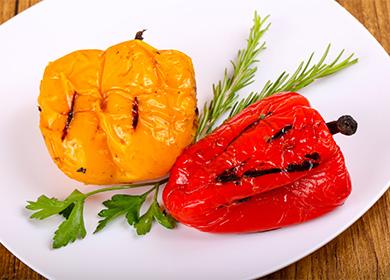Capsicum pizzas depends on how high the concentration of capsaicin in its composition. Sweet varieties, unlike the bitter ones (chili), contain a minimal amount of this substance. American chemist Wilbur Scoville at the beginning of the XX century proposed a scale that determines the degree of severity of different varieties of capsicum. The method of preserving pre-fried peppers is suitable for both sweet and bitter varieties of vegetables.
Selection of the main ingredient: sweet ...
Sweet pepper, a native of America, first came to Portugal and Spain, then to Turkey, and only in the 17th century the Bulgarians brought vegetables to Russia, which is why they call it “Bulgarian”. Six tips will help you choose a vegetable for preservation.
- Peduncle. A simple test for the freshness of the fruit: to break the tail, if droplets of liquid stand out - the vegetable has been plucked recently, if moisture has not appeared, pepper has been on the counter for a long time.
- Appearance. The surface of the fetus should be smooth, without bruises or wrinkles. If the skin has darkening, swelling and black spots, it is better to put the vegetable aside - it is infected with a fungus.
- Wall thickness. The ideal indicator is 8-9 mm, such vegetables are very juicy, fleshy.
- Weight. The heavier the fruit, the juicier it is. The weight of one vegetable should be at least 100 g.
- Density. The pepper should not deform when pressed, a good fetus can’t change its shape by pressing its fingers.
- Colour. Sweet pepper of different colors differs in composition: red is rich in vitamins A, E, C, P, in yellow there is a high concentration of phosphorus and potassium, in green there is a lot of phytosterol, which fights with "bad" cholesterol. To taste, red pepper is sweeter, and green after heat treatment acquires a bitterness.
... and hot peppers
When choosing hot pepper, you need to break the pod: a good sign if it bends rather than breaks. If orange spots appear on the surface of the fruit, the vegetable is affected by bugs. All varieties of hot vegetables differ in color, shape, taste intensity. The table below describes the main varieties of chili.
Table - Varieties of hot pepper
| View | Specificity |
|---|---|
| Jalapeno | - Green - medium severity; - red - very sharp; - "snub-nosed" form; - combined with cheese and meat; - common in Mexican cuisine |
| Anaheim | - green; - the softest in severity; - It is used more often as a vegetable, rather than a spice; - elongated pod; - is a part of ketchup and curry; - It is combined with rice, vegetable and meat dishes, legumes |
| Blanched | - green; - large fruits; - medium severity; - used for baked and slow-cooking dishes |
| Serrano | - green; - a small fruit in the form of a bullet; - very sharp; - only added to sauces |
| Habanero | - red; - wrinkled, rounded fruit; - the sharpest of all varieties; - is added to dishes entirely during cooking, before serving |
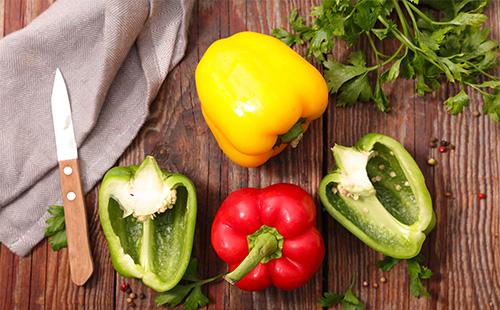
The specifics of conservation
The specificity of the method is that the pepper is fried before being rolled into jars.The heat-treated vegetable can be preserved in two ways.
- Pickling. Vegetable is poured with marinade, the main component of which is vinegar. It is on this method that the recipes of fried pepper for the winter without sterilization are based. The method takes a little time. The ability to do without sterilization is achieved through preliminary heat treatment of the vegetable and the use of acetic acid. After pouring the hot marinade, the cans are rolled up, turned upside down and wrapped in a blanket until completely cooled.
- Preservation without vinegar. Pepper is prepared using a large amount of vegetable oil, which acts as a preservative. However, in order to keep such blanks for a long time, they must be sterilized in a steam bath.
For sterilization, put a cotton or linen towel folded in several layers into a large pan, put the workpieces into the vessel, covering (but not closing) their lids. Pour water into the container so that the liquid hides the cans “on the shoulders”, boil, note the time. The duration of sterilization depends on the volume of containers with preservation and is shown in the table below.
Table - Duration of sterilization of workpieces
| Volume of cans (in liters) | Time (in minutes) |
|---|---|
| 0,5 | 10-15 |
| 1 | 20-25 |
| 2-3 | 30-35 |
After sterilization, roll up the jars, turn them upside down and place them on a tray, wrapping them in a blanket. After final cooling, after about a day, preservation can be removed for storage. You can keep such a product even at room temperature.
The subtleties of cooking
In order to make the workpiece more beautiful and bright, it is recommended to use fruits of different colors. Here are three more recommendations that will help you stock up on delicious preservation.
- Preparation of cans and lids. Billets that will be stored for a long time are laid out in cans previously washed with soda or laundry soap and sterilized in an oven, slow cooker or steam bath. Cover or pour boiling water, or boil for five to ten minutes.
- Cutting. You can stock up with canned fried pepper for the winter by putting the vegetable in a jar whole without removing the seeds and stalks. In this case, the harvesting process will be significantly accelerated, but the fruit will have to be cleaned before serving.
- Roasting. When frying, peppers begin to “shoot”, therefore, in order not to stain the stove, it is recommended to cover the pan with a lid, and wrap a hand with a towel when stirring to protect it from burns.
Fried peppers for the winter: 8 variations
American environmentalists, with the participation of gastroenterologists and nutritionists, have created an anti-rating of fruits and vegetables that can accumulate pesticides. This list is called the "dirty dozen," and sweet pepper takes third place in it. Therefore, before eating the vegetable, it is necessary to thoroughly rinse it with running water and soda, and then soak it for half an hour (no more) in a weak saline solution. It is enough to wash hot pepper with running water with soap or soda.
Garlic
Features To preserve fried pepper with garlic for the winter, you can take a vegetable with a tail, or cut the stem and clean the seeds. The fruit can be chopped into slices or left whole. The amount of ingredients is calculated per liter jar.
Components:
- Bulgarian pepper - 700 g;
- garlic - two heads;
- garlic - a bunch;
- salt - two teaspoons;
- sugar - four teaspoons;
- vinegar 9% - two teaspoons;
- water - how much will go into the jar;
- Refined vegetable oil - for roasting.
Technology
- In a frying pan heated with vegetable oil, fry pepper on all sides until browning.
- Chop the dill, chop the garlic into small cubes.
- Put pepper in layers in a jar, pouring garlic and dill.
- Pour salt, vinegar, sugar into a container.
- Pour boiling water into a jar, roll up.
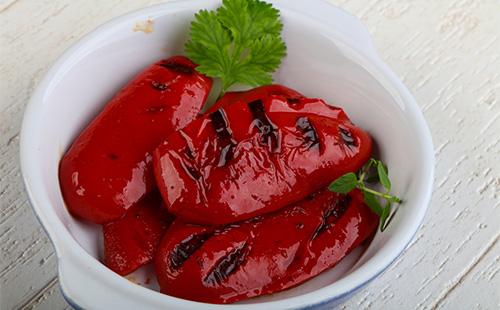
Baked
Features You can stock up on bell peppers with garlic for the winter without frying. Instead, the vegetable is baked in the oven: to taste, this product does not differ from what is cooked in a pan. The number of products is calculated on a half-liter can.
Components:
- sweet pepper (peeled) - 0.5 kg;
- garlic - three to four cloves;
- vegetable oil - 50 ml;
- a 9% bite and sugar - two tablespoons each;
- salt - a teaspoon;
- black pepper and allspice - four peas each.
Technology
- Chop the main ingredient into slices.
- Cover the baking sheet with foil, pour out all the vegetable oil, evenly distributing it around the entire perimeter. Put pepper in one layer. Bake for half an hour in an oven preheated to 220-230 ° C.
- Put spices and chopped garlic, sugar and salt into a jar, pour in vinegar.
- Put pepper in a container, pour oil from a pan into a jar.
- Pour boiling water to the brim, roll up.
Fast
Features In this way, it is convenient to preserve whole fried peppers. Harvesting is usually used as a complement to other dishes, and not as an independent dish. The specificity of the method is that the preparation is done without water.
Components:
- sweet pepper - 5 kg;
- flavourless vegetable oil and vinegar - 0.5 liters each.
Technology
- Pour oil into a cauldron and deep-fry the whole pepper.
- Put two or three fruits in a jar, pour with two tablespoons of vinegar. Repeat the sequence until the jar is full. Pour two tablespoons of vinegar with the last layer, roll up.
Tomato
Features Tomatoes in the recipe can be replaced with an equal amount of tomato sauce. The products indicated in the recipe are enough for two liter cans.
Components:
- sweet pepper - 2 kg;
- tomatoes - 1 kg;
- onions - 700 g;
- vegetable oil - 400 ml;
- salt - one or two tablespoons.
Technology
- Chop pepper into bars, tomatoes in thick circles, onions in a narrow strip.
- Pour half the oil into a preheated pan and add pepper, fry the vegetable for five to seven minutes, salt to taste.
- Remove the pepper from the pan and fry the tomatoes and salt in the remaining oil for two to three minutes.
- After tomato spasserovat onion until golden.
- Put the workpiece in cans in layers: pepper, onion, tomatoes. Repeat the sequence until the containers are full.
- Sterilize blanks, roll up.
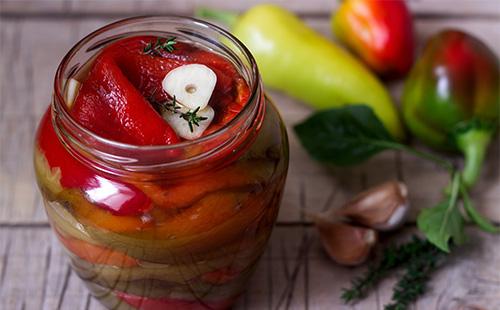
Eggplant
Features Harvesting with eggplant to taste and appearance resembles caviar, as vegetables are fried at the same time.
Components:
- eggplant - 2 kg;
- tomato paste - 800 g;
- sweet pepper - 12 fruits;
- sugar - two glasses;
- vegetable oil - a glass;
- garlic - 150 g;
- vinegar 9% - two tablespoons;
- greens to taste.
Technology
- Pour so much water into the paste to make 3 liters of liquid.
- Mix vinegar, oil, sugar and salt.
- Cut the eggplant into half rings, pepper - into narrow bars, garlic - into small cubes.
- Fry vegetables with chopped herbs in a pan for three minutes, pour tomato dressing and simmer over low heat for half an hour after boiling the mixture.
- Distribute to banks, roll up.
Acute
Features To make the fried pepper in the marinade sharper for the winter, bitter varieties are introduced into the preparation. Chili seeds and partitions are the hottest part of the pod, so you can either leave or remove them, depending on your preference. The finer chopped hot pepper, the more burning preservation. There is enough food for a 0.5 liter jar.
Components:
- sweet pepper - five pieces;
- hot pepper - one pod;
- vegetable oil - 200 ml;
- garlic - two cloves;
- vinegar 9% and sugar - two tablespoons;
- salt - a teaspoon.
Technology
- Cut each sweet pepper fruit in half, free from seeds and stalks.
- Chop the garlic in small cubes, leave the whole chilli or chop.
- In hot oil, fry bell pepper on all sides.
- Put garlic and chili in a jar, then lay out the main ingredient, add salt, sugar and vinegar, pour boiling water to the top, roll up.
Burning
Features For the winter, you can also stock up with hot fried peppers, use the least hot varieties in combination with other ingredients as the main ingredient. The volume of products indicated in the recipe is enough for two half-liter cans.
Components:
- hot green pepper - 1 kg;
- tomatoes - 600 g;
- garlic - three cloves;
- onions - one piece;
- vegetable oil - 200 ml;
- salt - a teaspoon;
- ground coriander - a quarter of a teaspoon.
Technology
- Chop the onion finely, free the tomatoes from the skin and chop into small pieces.
- In hot oil, spasser the onion until golden, add tomatoes and, stirring constantly, fry the vegetables until the moisture evaporates.
- Pepper to get rid of the stalks and mix in the tomatoes. After the fruits are tied, inject crushed garlic and coriander.
- Put the blank on the banks, sterilize, roll up.
Georgian
Features For the winter, bitter fried peppers can be preserved in Georgian. The peculiarity of the method is that the main ingredient is fried not in oil, but in marinade.
Components:
- green bitter pepper - 2.5 kg;
- garlic - 150 g;
- celery root - 100 g;
- white wine vinegar - 0.5 l;
- vegetable oil - a glass;
- parsley - 50 g;
- sugar - three tablespoons;
- laurel - five sheets;
- salt to taste.
Technology
- Cut a stalk from each pepper.
- Pour vinegar, oil into the pan, mix, salt and sugar, laurel. Boil.
- Immerse half the pepper in the liquid and cook for seven to ten minutes, turning the fruits so that they are "fried" on all sides. Prepare the remaining pepper in the same way.
- Remove the vegetable from the pan and cool the marinade.
- Chop the parsley, finely chop the celery and garlic. Pour the ingredients into the marinade.
- Boil over moderate heat, cook for two to three minutes.
- Connect the pepper with the marinade, insist a day in the refrigerator.
- Fold the blank in jars, pour the marinade, roll up.
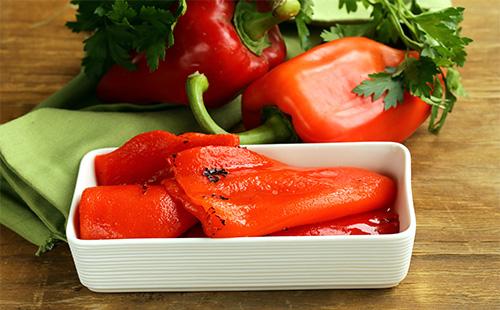
How to serve
Fried sweet pepper can be served as an independent cold snack, or you can use it as a part of other dishes, including hot ones, because preservation is good even when heated. Here are three ways to deliver your workpiece in the original way.
Warm salad
- Fry 300 g of chopped chicken fillet until ready to fry.
- Add 100 g of canned fried pepper to the pan and heat the mass, stirring one or two minutes.
- Cover a large flat dish with lettuce, then lay the fry.
- Garnish with chopped cherry tomatoes.
- Sprinkle with grated Parmesan.
Casserole
- Chop the onion, spasser in vegetable oil until translucent.
- Stir in 400 g of chopped chicken fillet and fry until the meat is ready.
- Put the fry in the baking dish.
- In the same pan, fry the carrots processed by a coarse grater (one or two hearths) and put the vegetable on the chicken with onions.
- Spread 100-200 g of canned fried pepper on the carrots around the perimeter of the workpiece.
- Five to six large potatoes are cut into rings or half rings and folded into a baking dish with the next layer.
- In 100 ml of sour cream, stir one or two crushed cloves of garlic and grease the casserole with sauce.
- Sprinkle with grated cheese, cover with foil and send to the oven preheated to 180 ° C for half an hour.Ten minutes before the foil is ready to remove, so that the casserole is browned.
A sandwich
- Fry two square slices of wheat bread in a dry frying pan.
- Put a lettuce leaf, a piece of cheese, a slice of tomato and a few slices of canned fried pepper on one “toast”.
- Close the workpiece with a second piece of bread.
You can implement fried pepper recipes for the winter by following them step by step, or you can make small changes to make the preparation “with a twist”. For example, add broken bay leaves, cloves, coriander, caraway seeds, dried rosemary and other spices. In order for flavoring additives to “open up” better, it is recommended that they be heated in a dry skillet for one to two minutes.
